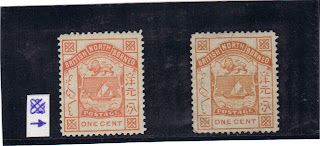1909 10c Wild Boar blue, turquoise blue and grayish blue
1909 12c Palm Cockatoo deep bright blue and deep blue1909 6c Rhinoceros olive green and apple green
1909 5c Elephant yellow brown and dark brown
1897 8c Malay Dhow brown and brown- purple
1897 10c Sun Bear slate-blue and slate- lilac
1897 5c Great Argus Pheasant orange-vermilion and lighter shade probably bleached by sunlight.
1886 1c orange and orange-yellow. note printing flaw of left bottom rosette.
1899 4c on 50c slate-purple and chalky blue
These are the common shades listed in the SG catalogue but the definitive text by Shipman and Cassels listed a lot more. Colour shades have several different causes. The printer may use a different ink; in the early days, inks were made up in batches as needed, and were rarely consistent. In such cases, the shade provides information about when the stamp was made, and possibly even identify a particular printing. Extreme variations may be considered colour errors. Inks may also be diluted or applied more thinly. It can also happen randomly, if a printing plate is accidentally under-inked.Ultraviolet light is destructive to a great many pigments, and can cause considerable lightening. In addition, some countries have used water-soluble materials known as fugitive inks to prevent reuse. Stamps of this type may be much lighter in color after being soaked.Some dramatic color variations occur as a result of chemical action; such stamps are called colour changelings. Forgers have also used chemicals to try to produce seeming rarities, although by now experts know how to identify these attempts.







No comments:
Post a Comment